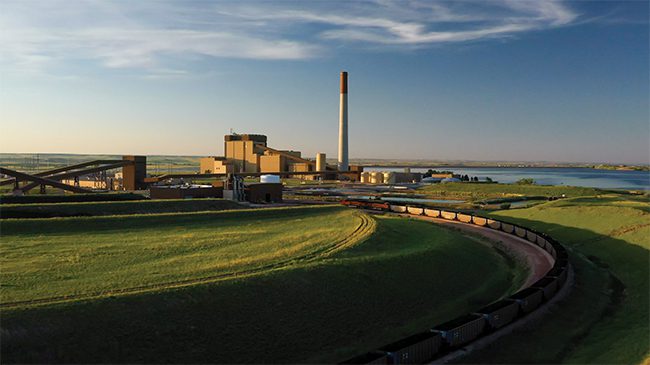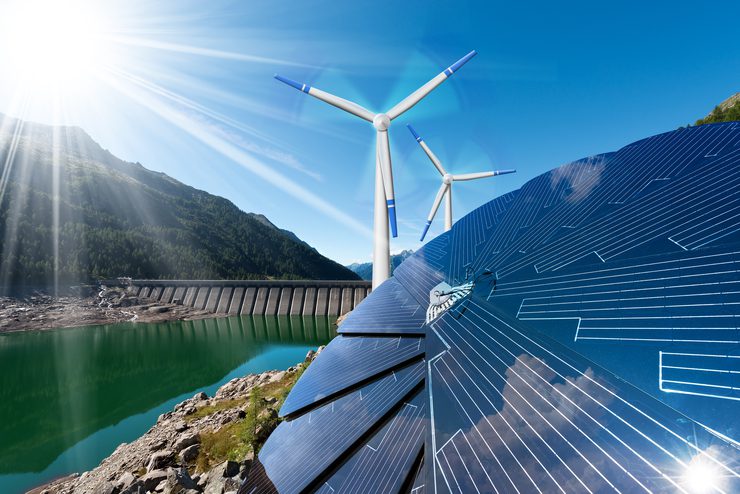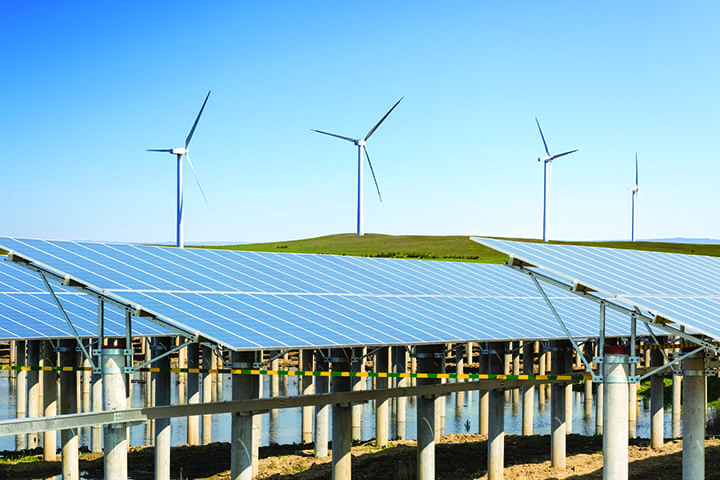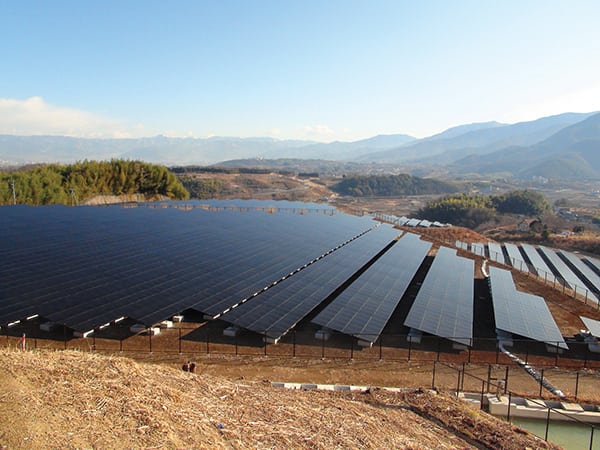The boom in renewable energy, spurred by dramatically falling costs, has led some experts and political figures to begin talking seriously about what was once science fiction: A world powered entirely by renewable generation. But is it truly feasible or economic? One series of studies suggests it is—with some important caveats.
In the first half of the 20th century, as the world struggled to come to terms with dramatic leaps in technology across transportation, communication, and energy production, one favorite activity of media organs was speculating about what the world would look like 50 or 100 years in the future. Popular Mechanics magazine was a favorite forum for such predictions, and in the February 1950 issue, Waldemar Kaempffert, then science editor of The New York Times, took a stab at describing what the cities of the 21st century would look like.
Among some fairly eye-opening ideas (for example, housewives of the 2000s throw everything away—laundry included—instead of cleaning because synthetic manufacturing has become so cheap and efficient), Kaempffert offers some predictions on energy that, if inexact, are nevertheless awfully prescient for 2017. “It is a crime to burn raw coal and pollute air with smoke and soot,” he writes, and “[p]ower plants are not driven by atomic power as you might suppose.” Why? It’s too expensive: “Because of the heavy investment that has to be made in a uranium or thorium power plant,” he says, attention would soon turn to solar energy. “Atomic power proves its worth in Canada, South America and the Far East, but in tropical countries it cannot compete with solar power.”
In 1950, the idea of powering an entire country with solar energy was science fiction. But in 2017, it’s become—paired with wind and other renewable generation—an idea many experts and policymakers are talking about as an entirely feasible goal. Municipalities around the world have made 100% renewables targets a matter of law, large corporations like Google and Amazon have declared intentions to source all their power needs from renewables (Figure 1), and even a few countries such as Denmark that currently rely on fossil fuels for a substantial portion of their power are targeting 100% renewable generation in the next few decades. Most recently, the COP21 Paris climate agreement set a target of 100% renewables worldwide by 2050.
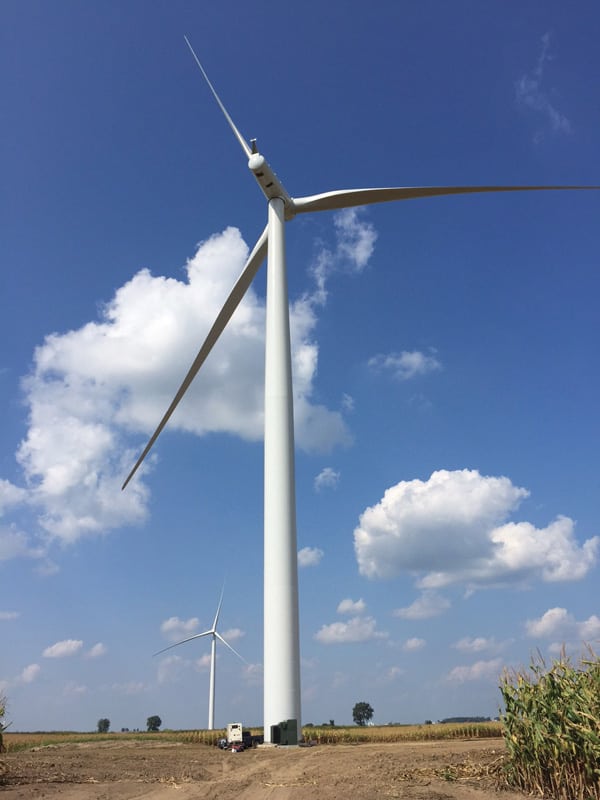
A Question of Labels
But is it really possible, as a matter of economics and engineering, to transition an entire national grid from fossil fuels to renewables in just a few decades? At the outset, it needs to be recognized that multiple national grids operating on 100% (or close to it) renewable energy sources already exist. But all of them are nations that benefit from a combination of small populations and large hydroelectric capacity: Iceland, Norway, Costa Rica, Paraguay, and Uruguay (Figure 2). The south island of New Zealand also gets virtually all of its electricity from hydropower. The largest of these—Paraguay—has a population smaller than New York City or London, and far smaller than giant cities like Shanghai or Delhi. Other nations and regions with high renewable penetration, such as Germany and Portugal, have at times of low demand and high renewable output met or nearly met all electricity demand with renewable generation.
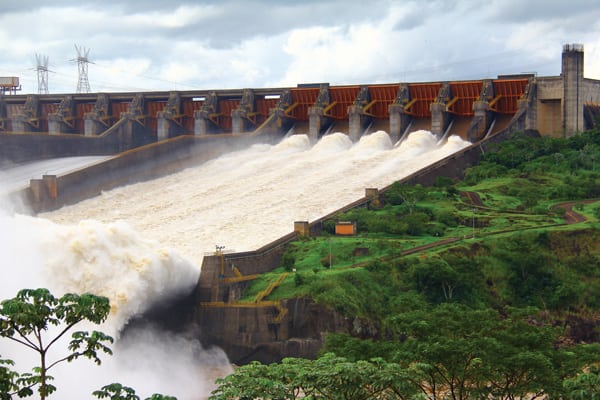
A few island grids have also gone 100% renewable, though not always with complete success. The Spanish island of El Hierro in the Canaries announced with much fanfare in 2014 a scheme to generate all of its electricity from wind turbines and a pumped hydroelectric storage facility (see “A Spanish Island’s 100% Wind-and-Water Power Solution” in the August 2014 issue). In practice, however, the project has struggled to meet expectations, generally supplying only a fraction of the island’s demand.
Answering the titular question requires agreeing on certain definitions. Nuclear is generally considered low-carbon generation but is not usually included in 100% renewable scenarios for a variety of reasons, usually environmental but also including proliferation concerns. Many countries, especially in Europe, have grids that are deeply interconnected with each other, and in these cases nations with high renewable penetration often rely on neighboring grids for balancing purposes, much as a home with a large solar array and no storage needs a grid connection even if its net generation may be zero. Denmark, for example, met 52% of its demand with renewables in 2015, but it also imported 20% of its electricity. Scenarios like the latter are not fairly viewed as “100% renewable.”
Corporate and municipal pledges to source 100% of energy needs from renewables also need some context, as these are typically just “100% renewable equivalent.” In Google’s case, the firm is actually buying and selling renewable energy around the world in order to earn renewable energy credits, then applying those credits to the regular grid connections for its data centers. No Google data center is actually operating entirely off a solar or wind farm. Then there’s the Silicon Valley town of Menlo Park, not far from Google’s world headquarters. The municipality has made a pledge to go “100% carbon-free” by 2025, but this is actually zero net carbon. The goal is to generate or procure 100% of the city’s electricity consumption from renewables, but it’s still going to be connected to the local Pacific Gas & Electric grid.
2.5 Million Wind Turbines
So what about transitioning the entire world to 100% renewables, without relying on offsets and shell games? The subject has, not surprisingly, been a fertile ground for academic study. Scientists have looked at the possibility of 100% renewable generation for decades, but until very recently such studies have been mostly speculative because of the lack of real-world data on how grids perform with high levels of intermittent generation. With the lessons of the past few years, however, a number of detailed scenarios have been published.
Stanford University engineering professor Mark Jacobson and University of California, Berkeley researcher Mark Delucchi have authored a series of studies laying out in detail how both the world and the U.S. could meet all energy needs (not just electricity but also transportation and heating/cooling) with a combination of hydroelectric, geothermal, wind, and solar generation. A two-part 2011 study in the journal Energy Policy (see http://stanford.io/2jIYd4L and http://stanford.io/2ikU2a4) and an ongoing updated version (see http://stanford.io/1lvUaVS) describe how an estimated 20.6 TW of total world energy demand in 2050 could be supplied by about 52.1 TW of renewable capacity plus storage and energy efficiency gains:
■ 2.5 million 5-MW wind turbines (60/40 mix of on- and off-shore) (37%)
■ 409,000 0.75-MW wave generators (0.5%)
■ 935 100-MW geothermal plants (0.7%)
■ 1,058 1.3-GW hydroelectric plants (4%)
■ 30,000 1-MW tidal turbines (0.06%)
■ 1.8 billion 5-kW residential rooftop solar photovoltaic (PV) systems (15%)
■ 75 million 100-kW commercial PV systems (12%)
■ 250,000 50-MW solar PV plants (21%)
■ 21,500 100-MW concentrating solar power (CSP) plants with thermal storage (10%)
■ 13,000 100-MW CSP plants with thermal storage (additional for grid support)
■ 85,000 50-MW solar thermal storage plants (for direct heating)
The mix of technologies (which the authors refer to as “wind, water, and solar” or WWS) reflects the need for dispatchable generation and that the most economic solution will vary by location. The list above includes already-existing resources, particularly hydro (of which all the listed capacity is currently in operation), but this accounts for only 4.26% of the total. Notably, the scenario does not include any stationary electric storage batteries.
In this scenario, all uses that can be, have been electrified, and the remaining needs are supplied by hydrogen sourced from electrolysis, either combusted directly or used in hydrogen fuel cells. The estimate assumes advances in energy efficiency, demand reduction, and reduced energy usage in a world without fossil fuels (for example, energy usage by petroleum processing is vastly lower, while the use of centrally generated electricity is much more efficient than distributed combustion) lower total energy needs to 11.8 TW (which suggests an average 22.6% capacity factor for the resources in the list above). Under this scenario, the world would reach 80% renewables by 2030 and about 95% by 2040 (Figure 3).
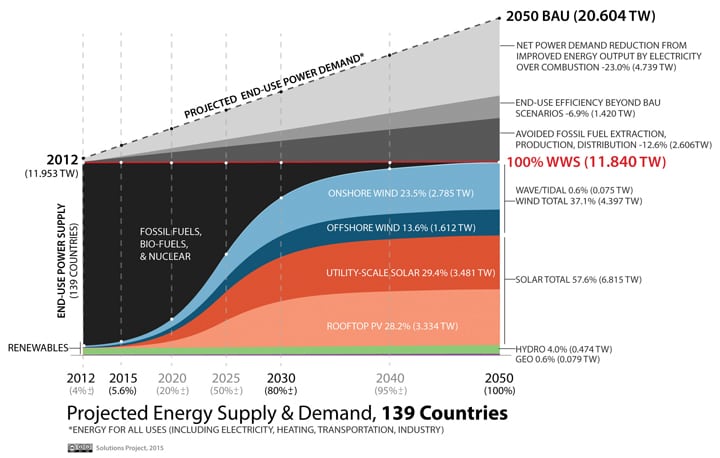
The 2011 study identifies a few bottlenecks in terms of resources, one of which is the availability of neodymium (Nd) needed for wind turbine generator magnets—world production of Nd would need to be increased five-fold to meet demand, something that may not be feasible. Thus, alternatives to Nd-based magnets would be necessary. Production of the necessary PV cells would not challenge existing resources, but production of electric vehicle batteries under this scenario could potentially exhaust known reserves of lithium in as little as 20 years. The authors suggest this is likely to drive up lithium prices, incentivizing recycling and development of possible new resources. Meeting demand for platinum used in fuel cells would also require increased recycling.
Maintaining reliability on a grid with greater than 80% intermittent resources requires some additional changes, but the authors argue that this challenge can be met through a mix of approaches: greater interconnection (including international “supergrids”), smart demand response, better forecasting, energy storage (including distributed thermal storage and vehicle-to-grid), and oversizing generation capacity, with any excess generation being directed toward hydrogen production. Absent the hydrogen production, these are measures that a number of other groups such as the World Energy Council (WEC) have also discussed as necessary for greater renewable integration.
A 2015 follow-up study (see http://stanford.io/1IdZB0I) ran a model over six years that demonstrated that such an approach in the U.S. could meet conventional utility standards for reliability. (For some recent POWER articles on these subjects, see “Utilities Grapple with Storage Integration” in the December 2016 issue, “The Future of Load Control for Solar PV” in the December 2015 issue, and “Reducing Weather-Related Risks in Renewable Generation” in the January 2015 issue.)
The Price Tag
What would all this cost? A lot. The 2016 update estimates the total worldwide capital cost at about $125 trillion in 2013 dollars. (By way of comparison, the gross world product in 2013 according to the World Bank was a mere $75 trillion.) But much of that money would be spent anyway on other energy resources under a business-as-usual approach. How would the 100% renewable scenario compare? For one thing, the study argues, the levelized cost of energy in 2050 would be less expensive, though not by much (roughly $85/year per capita worldwide). The main benefit would be avoided health and climate impacts of around $5,800/year per capita.
There are other costs as well, particularly a major shift in energy sector employment. While the study estimates that transitioning to 100% renewables would generate 25.4 million construction jobs and 26.6 million new jobs, it would also eliminate 27.7 million current jobs. These shifts would not be evenly distributed, with countries that rely on fossil-fuel extraction for a significant portion of their economies suffering disproportionate losses.
Another 2015 study looked at making such a transition in the U.S. Under that scenario, total U.S. generating capacity expands from 1,167 GW in 2015 to 6,447 GW in 2050, with the relative percentages of each type of generation slightly different from the list above (more wind and less solar), while total demand falls around 40%, as with the global studies. The total cost of this capacity would be about $13.4 trillion in 2013 dollars, spread over several decades (the U.S. gross domestic product in 2013 was a bit less than $17 trillion).
By 2050, however, the levelized cost of 100% renewable generation, including additional transmission and storage, is predicted to have fallen below conventional generation even without including external health and climate costs. “WWS energy in 2050 will save the average U.S. consumer $260 (190–320) per year in energy costs ($2013 dollars),” the study says. “In addition, WWS will save $1500 (210–6000) per year in health costs, and $8300 (4700–17 600) per year in global climate costs.”
Uncertainties and Caveats
Though Jacobson and Delucchi have broken ground in their degree of detail, other researchers as well as entities such as the National Renewable Energy Laboratory, the International Renewable Energy Agency, the WEC, and the World Wildlife Fund have looked at what it would take to transition to 100% renewables worldwide. A 2013 study by researchers at the University of Delaware came to similar conclusions using performance data from PJM, finding that 99.9% renewables by 2030 was feasible but would require substantial overcapacity and had to include externality costs to be economic compared to fossil fuels.
When speaking of targets decades out, many of the predictions underlying these roadmaps are necessarily speculative. Estimates of savings in climate change impact costs also necessarily have a high degree of uncertainty because of the difficulties in predicting how changes in global temperatures will affect human activity.
It’s worth noting, though, that one reason the Jacobson and Delucchi studies discussed have been updated repeatedly is that the costs of wind and solar generation have fallen faster than expected. The projections in the original 2011 studies proved to be too conservative, with the market in some cases reaching 2020 estimates as early as 2016 (Figure 4).
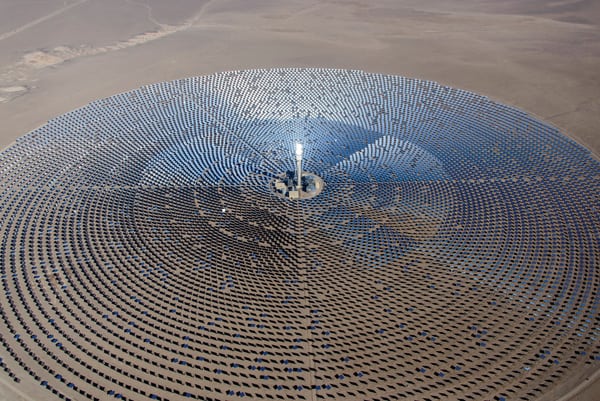
Other critics have focused on the exclusion of nuclear, arguing that simply displacing what is already a low-carbon resource that provides about 10% of the world’s electricity in favor of another low-carbon resource isn’t the most efficient approach and unnecessarily delays a transition to low-carbon generation (depending on what study you look at, nuclear has about the same to slightly higher carbon emissions than wind and solar, but far less than coal or gas). These critics also point out that nuclear achieves far higher capacity factors than wind and solar, while also beating them by a large margin on power density.
While most of these studies recommend a variety of policies to support the transition, the question of whether such a program is politically and socially feasible remains open. Most of the policy recommendations are broad, top-down approaches more suitable to regions like China and the European Union. As but one example, China has spent much of the last year ordering halts to the development and construction of hundreds of coal-fired power plants, something that would be far more difficult in the U.S. (and would also result in protracted litigation). Yet even China has run into substantial problems with underutilization of its vast wind capacity—by far the largest in the world at 145 GW—because of a variety of political and economic factors. (And China is also highly unlikely to abandon its rapidly growing nuclear fleet.)
The U.S., with its much more decentralized political structure is likely to move more slowly, even without considering a national political climate that has shifted repeatedly on support for renewables. Whatever the possibilities, the reality is likely to take longer. ■
—Thomas W. Overton, JD is a POWER associate editor.





